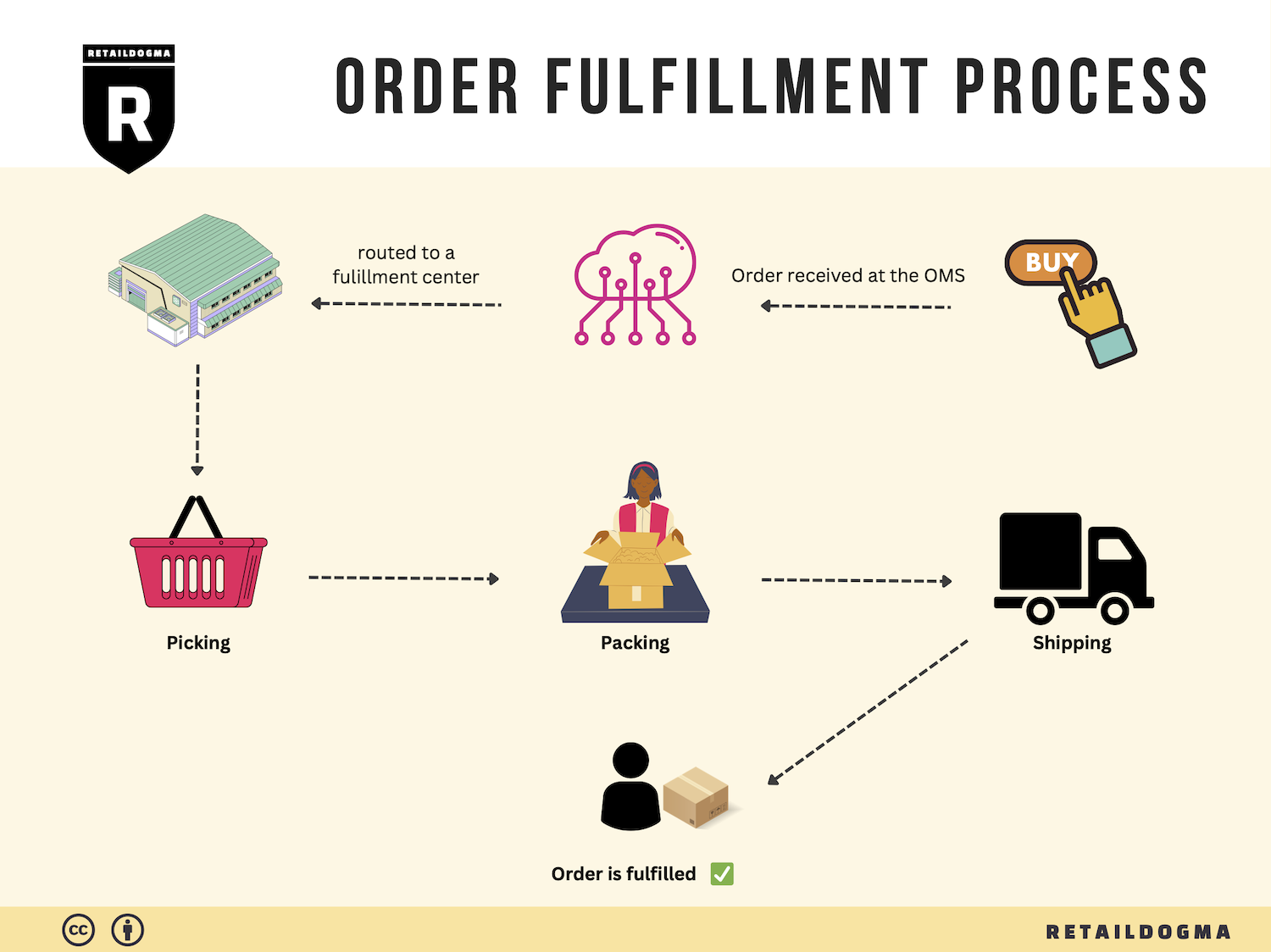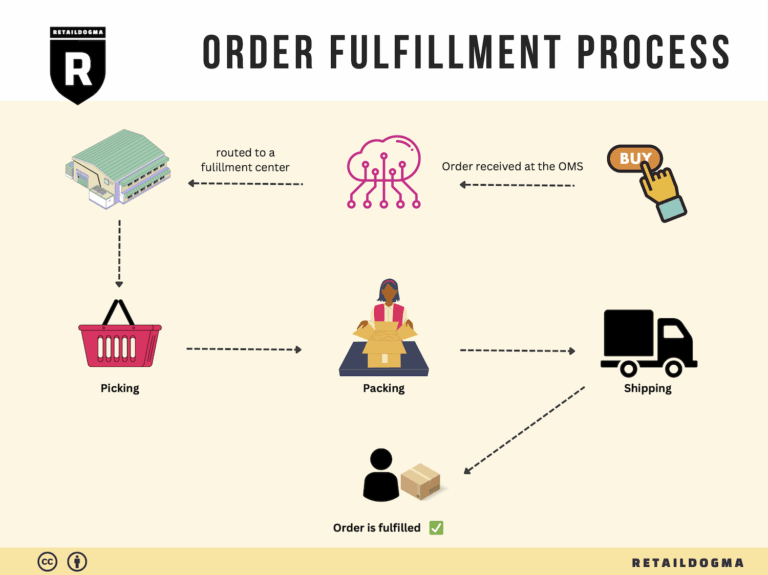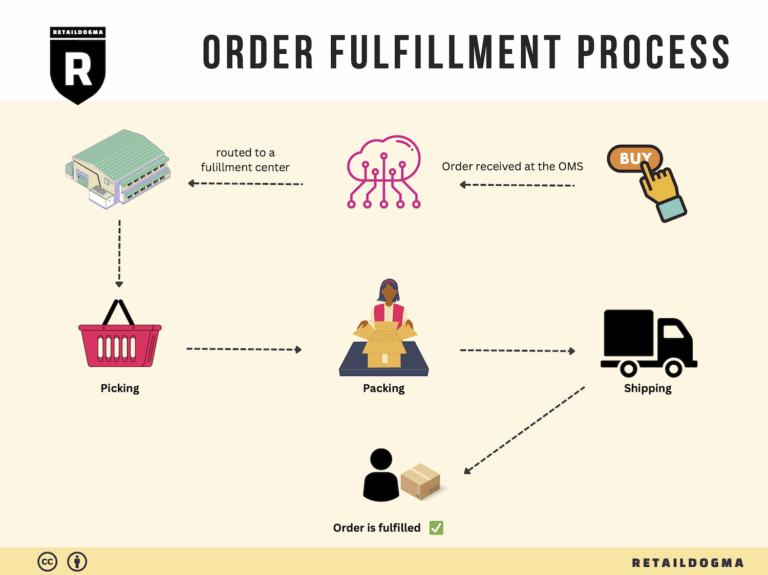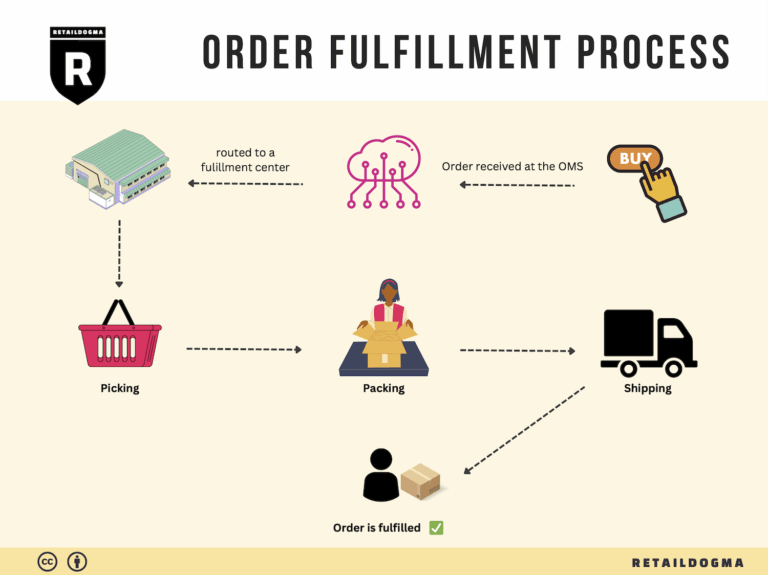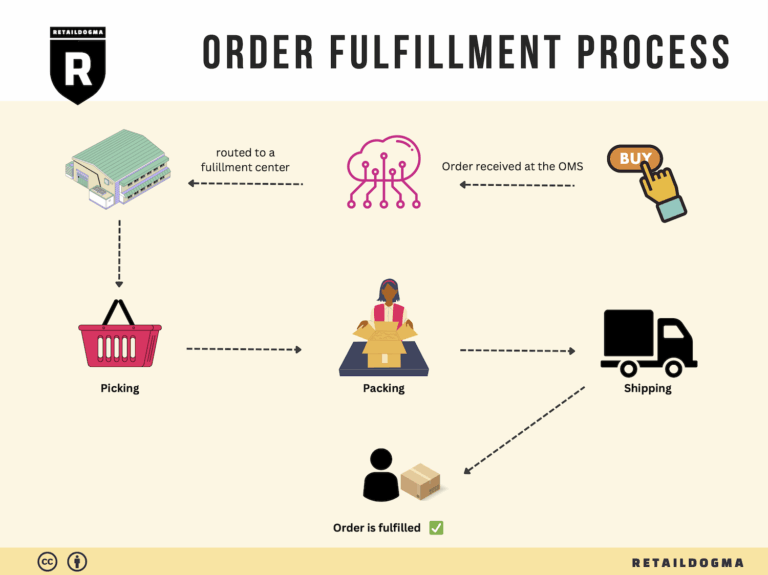Ecommerce Fulfillment Services: The Ultimate Guide (2025)
What is E-commerce Fulfillment? An Introduction for Growing Businesses
Understanding E-commerce Fulfillment
As an e-commerce business owner, you may find yourself overwhelmed by the demands of packing and shipping orders, especially as your sales begin to grow. Managing logistics can quickly become a daunting task that diverts your focus from core business activities, such as marketing and product development. This is where understanding and optimizing your fulfillment strategy becomes crucial.
E-commerce fulfillment is the comprehensive process of getting a product from your inventory to the customer’s doorstep. It encompasses everything from receiving and storing products to picking, packing, and shipping orders. The efficiency of this process directly impacts customer satisfaction and retention, making it a vital component of your business’s success.
In this guide, we will explore the various fulfillment models available to e-commerce businesses, including Third-Party Logistics (3PL) and Fulfillment by Amazon (FBA). Each model has unique benefits and challenges, and understanding these can help you choose the right approach for your business needs.
We will also delve into the core services associated with fulfillment, such as inventory management, order processing, packaging, and shipping. Knowing these services will empower you to identify which aspects of fulfillment you can manage in-house and which should be outsourced to a partner.
Choosing the right fulfillment partner is another critical decision that can influence your operational efficiency. We will provide practical tips on evaluating potential partners based on their capabilities, technology, location, and customer service. This will help you make informed decisions that align with your business goals.
Finally, we will discuss pricing models in fulfillment, including per-order fees, storage costs, and shipping expenses. Understanding these costs will allow you to budget effectively and maximize your profit margins.
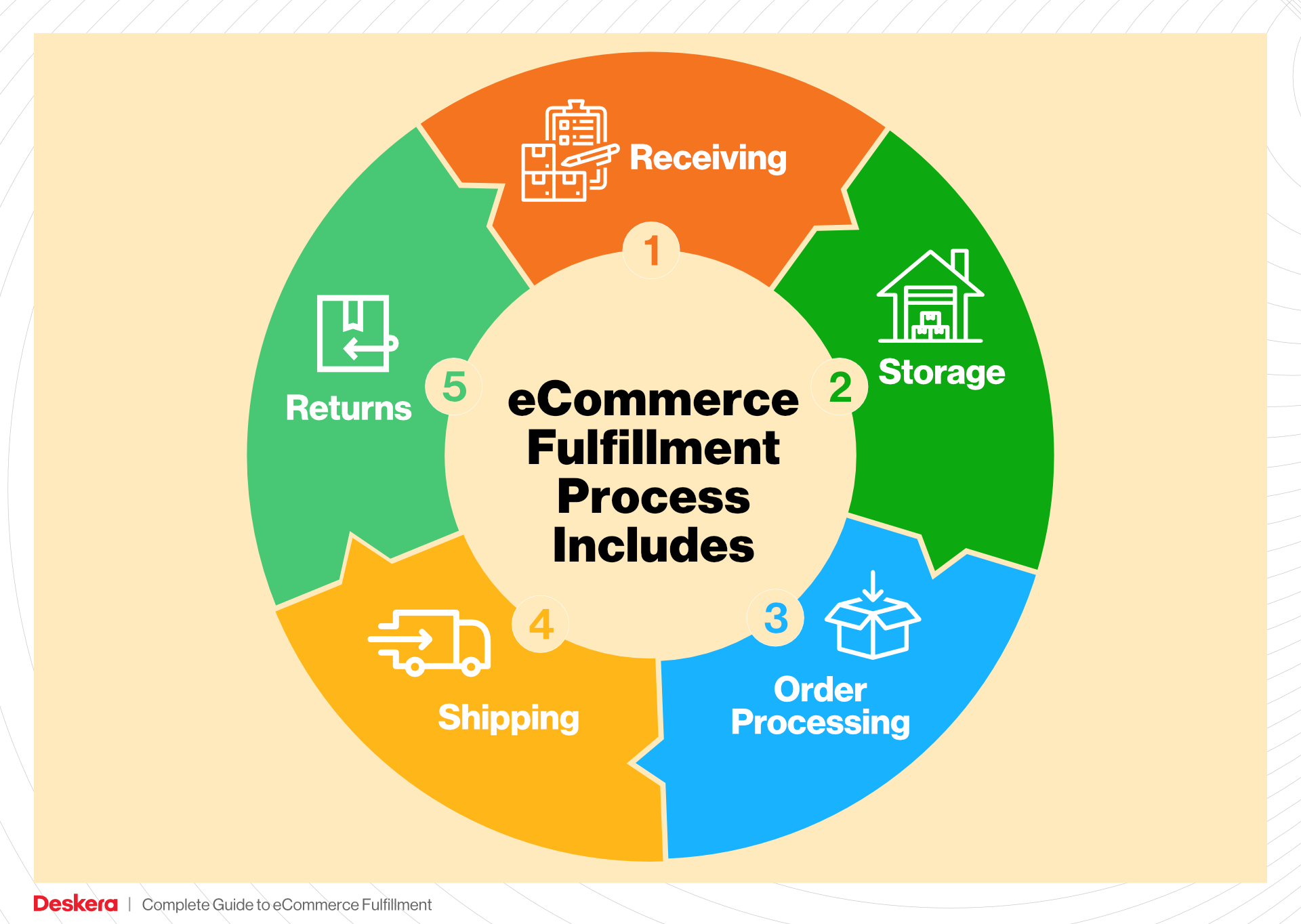
The goal of this guide is to empower you to make smart, strategic decisions regarding your logistics operations. By mastering the intricacies of e-commerce fulfillment, you can streamline your processes, enhance customer satisfaction, and ultimately scale your business with confidence. Whether you’re just starting out or looking to optimize your existing operations, this guide will serve as a valuable resource on your journey to fulfillment excellence.
What You’ll Learn In This Guide
- What is E-commerce Fulfillment? An Introduction for Growing Businesses
- The Order Fulfillment Process: From ‘Buy’ Button to Customer’s Door
- Comparing Fulfillment Models: In-House vs. 3PL vs. Dropshipping
- A Deep Dive into Amazon FBA: Pros, Cons, and Who It’s For
- Core Services Offered by Fulfillment Centers
- How to Choose a Fulfillment Partner: A 6-Point Checklist
- Understanding Fulfillment Pricing: A Breakdown of Common Fees
- Frequently Asked Questions (FAQs) about Fulfillment
- Conclusion: Is Outsourcing Fulfillment the Right Move for Your Business?
- Important Disclaimer
The Order Fulfillment Process: From ‘Buy’ Button to Customer’s Door
1. Receiving Inventory
The order fulfillment process begins with receiving inventory at the fulfillment center. This step involves the acceptance of products from suppliers, which can include manufacturers or wholesalers. Once the inventory arrives, warehouse staff must check the items against purchase orders to ensure that the right products and quantities have been delivered. This process often involves scanning barcodes or entering SKU (Stock Keeping Unit) numbers into inventory management systems.
Importance: Proper inventory receiving is crucial as it lays the foundation for accurate stock levels. Inaccurate counts can lead to stockouts or overstock situations, which directly affect customer satisfaction and operational efficiency.
Key Term: SKU (Stock Keeping Unit) – A unique identifier for each distinct product and service that can be purchased, which helps in tracking inventory efficiently.
2. Warehouse Storage
Once the inventory is received and verified, the next step is warehouse storage. This involves organizing the products in the fulfillment center using a systematic layout that maximizes space and efficiency. Items are typically stored in designated areas based on their size, type, and frequency of sale. Advanced facilities, like Amazon’s BDL4, utilize robotic systems to enhance storage efficiency, enabling rapid access to products.
Importance: Efficient storage solutions not only maximize the use of space but also streamline the picking process. A well-organized warehouse reduces the time employees spend searching for items, thereby improving overall fulfillment speed.
Key Term: ABC Analysis – A method of categorizing inventory into three classes (A, B, and C) based on importance and turnover rates, allowing for tailored management strategies.
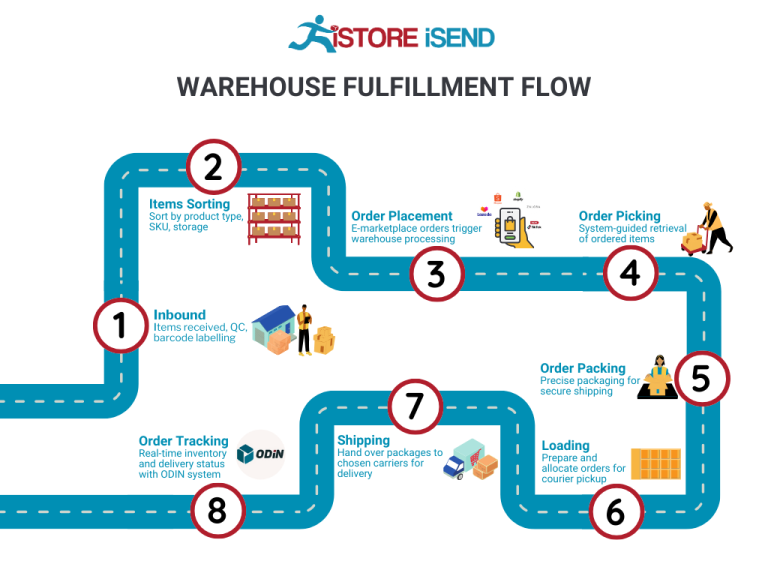
3. Order Picking
The next phase is order picking, where items are selected from storage based on customer orders. This process can be executed using various methods, including single order picking (picking one order at a time) or batch picking (picking multiple orders simultaneously). Warehouse staff use pick lists, which detail the items and quantities needed for each order.
Importance: Order picking is a critical step in the fulfillment process as it directly influences order accuracy and speed. Efficient picking minimizes errors and enhances customer satisfaction by ensuring that the correct items are shipped in a timely manner.
Key Term: Pick List – A document or digital list that guides warehouse staff in selecting the correct items for customer orders, essential for maintaining order accuracy.
4. Order Packing
After items are picked, they move to the order packing stage. Here, items are carefully packed for shipment. This may involve selecting the appropriate packaging materials (boxes, bubble wrap, etc.) to protect the items during transit. Custom-sized packaging solutions are increasingly common to minimize waste and reduce shipping costs.
Importance: Proper packing ensures that products arrive at their destination in excellent condition, which is vital for maintaining customer trust and brand reputation. Additionally, efficient packing can help optimize shipping costs, thereby improving the bottom line.
Key Term: Packing Slip – A document included with the shipment that lists the items in the package, serving as a receipt for the customer and a record for inventory management.
5. Shipping & Delivery
The final step in the order fulfillment process is shipping and delivery. Once orders are packed, they are labeled and sorted for shipment. This involves choosing the appropriate shipping method (standard, expedited, etc.) based on customer preferences and costs. The packages are then handed over to shipping carriers for last-mile delivery to the customer’s door.

Importance: Timely shipping and delivery are crucial for customer satisfaction, especially in an era where consumers expect rapid fulfillment. The ability to offer various shipping options can also be a competitive advantage.
Key Term: Last-Mile Delivery – The final step in the delivery process, where packages are transported from a distribution center to the end customer, often seen as the most crucial and challenging part of the shipping process.
By understanding and optimizing each of these five steps in the order fulfillment process, e-commerce businesses can significantly enhance their operational efficiency and customer satisfaction, ultimately driving growth and success in the competitive online marketplace.
Comparing Fulfillment Models: In-House vs. 3PL vs. Dropshipping
Fulfillment Model Comparison Table
| Model | Who Handles Inventory | Best For (Business Stage) | Key Advantage | Key Disadvantage |
|---|---|---|---|---|
| In-House Fulfillment | The e-commerce business itself | Established businesses with stable sales | Full control over inventory and processes | High overhead costs and resource demands |
| Third-Party Logistics (3PL) | A third-party logistics provider | Growing businesses seeking scalability | Cost-effective and scalable logistics solutions | Less control over inventory and fulfillment speed |
| Dropshipping | Supplier/manufacturer | Startups and small businesses | Low startup costs and no inventory risk | Lower profit margins and longer delivery times |
In-House Fulfillment
In-house fulfillment refers to a model where the e-commerce business manages its own inventory and shipping processes. This model is best suited for established businesses with stable sales and a clear understanding of their logistics needs. The key advantage of in-house fulfillment is the full control it provides over inventory management, order processing, and customer service. Businesses can tailor their fulfillment processes to meet specific customer demands and ensure quality control at every step. However, this model comes with significant disadvantages, such as high overhead costs associated with warehousing, staffing, and technology investments. Moreover, managing fulfillment in-house can strain resources, diverting focus from core business activities like marketing and product development.
Third-Party Logistics (3PL)
Third-party logistics (3PL) involves outsourcing inventory and order fulfillment to a specialized logistics provider. This model is particularly beneficial for growing businesses that need to scale their operations without the heavy investment in infrastructure. 3PL providers handle everything from warehousing and inventory management to shipping and returns. The primary advantage of utilizing a 3PL is the cost-effectiveness and scalability it offers. Businesses can leverage the expertise and resources of logistics specialists, allowing them to focus on their core competencies while ensuring efficient order fulfillment. However, the main drawback is the potential loss of control over inventory and fulfillment speed. Businesses may face challenges in communication and coordination with their 3PL partner, which can affect customer satisfaction if not managed properly.
Dropshipping
Dropshipping is a fulfillment model where the e-commerce business does not keep products in stock. Instead, when a customer places an order, the business purchases the item from a third-party supplier who then ships it directly to the customer. This model is particularly well-suited for startups and small businesses with limited capital, as it requires low startup costs and eliminates the need for inventory management. The key advantage of dropshipping is that it minimizes financial risk, as businesses only pay for products after they have been sold. However, dropshipping also has notable disadvantages, including lower profit margins and longer delivery times. Businesses may struggle with quality control and customer service, as they rely on suppliers for product availability and shipping. Additionally, a lack of inventory control can lead to stockouts or delays, potentially harming the customer experience.
Conclusion
Each fulfillment model offers unique advantages and disadvantages, and the choice largely depends on the specific needs and stage of your business. In-house fulfillment provides maximum control but at a higher cost, while 3PL offers scalability and efficiency, albeit with some loss of control. Dropshipping is a low-risk entry point for new businesses, but it comes with challenges related to margins and fulfillment speed. As e-commerce continues to evolve, understanding these models will enable business owners to make informed decisions that align with their growth strategies and operational capabilities.
A Deep Dive into Amazon FBA: Pros, Cons, and Who It’s For
Understanding Fulfillment by Amazon (FBA)
Fulfillment by Amazon (FBA) is a service provided by Amazon that allows sellers to store their products in Amazon’s fulfillment centers. Amazon takes care of storage, packaging, and shipping of these products directly to customers. This service not only streamlines logistics for sellers but also enhances customer experience by leveraging Amazon’s vast distribution network.
When a customer places an order for a product listed as FBA, Amazon handles the entire process, from picking and packing the item to shipping it and providing customer service. This enables sellers to focus on other aspects of their business, such as product development and marketing.
How FBA Works
- Setting Up an Account: Sellers must create an Amazon Seller account and enroll in the FBA program.
- Product Listing: Sellers list their products on Amazon, indicating which items will be fulfilled through FBA.
- Shipping Inventory: Sellers ship their products to Amazon’s fulfillment centers. Amazon has multiple warehouses, and they may direct sellers to send inventory to specific locations based on demand and logistics efficiency.
- Storage: Once received, products are stored in Amazon’s warehouses. The items are organized for efficient retrieval.
- Order Fulfillment: When a customer places an order, Amazon picks the item from the shelf, packs it, and ships it directly to the customer.
- Customer Service and Returns: Amazon handles all customer service inquiries and manages returns, which can be a significant advantage for sellers.
Pros of Using FBA
1. Prime Eligibility
Products fulfilled by Amazon automatically qualify for Amazon Prime, making them more attractive to millions of Amazon members. This can significantly boost sales, as Prime members are more likely to purchase items that offer fast, free shipping.
2. Enhanced Customer Trust
By using FBA, sellers benefit from Amazon’s established brand reputation. Customers often feel more secure purchasing items that are fulfilled by Amazon due to the reliable shipping, customer service, and return policies. This trust can lead to higher conversion rates for listings.
3. Multi-Channel Fulfillment
FBA allows sellers to fulfill orders from multiple sales channels, not just Amazon. This means that if a seller has an e-commerce store or sells on other platforms (like eBay or Shopify), they can still use Amazon’s logistics to fulfill those orders, streamlining operations and maintaining consistent delivery standards.
4. Scalability
Using FBA can significantly enhance a seller’s ability to scale their business. As sales grow, Amazon can handle increasing order volumes without the seller needing to invest heavily in logistics infrastructure.
5. Inventory Management
Amazon provides robust tools and analytics that help sellers manage their inventory effectively. Sellers can track stock levels, sales trends, and receive alerts when inventory is running low, ensuring they can optimize their stock levels and avoid stockouts.
Cons of Using FBA
1. High Fees
FBA comes with various fees, including storage fees (charged monthly based on the space your products occupy) and fulfillment fees (charged per unit sold). These costs can eat into profit margins, especially for lower-priced items or slow-moving inventory.
2. Strict Inventory Rules
Amazon has stringent requirements regarding inventory management and product quality. Sellers must adhere to these rules or risk penalties, including removal of inventory or account suspension. This can be challenging for small businesses without dedicated logistics teams.
3. Commingling Risks
FBA allows for commingling of inventory, meaning that sellers’ products may be stored alongside those of other sellers. This can lead to issues if products are damaged or if customers receive the wrong item, potentially harming the seller’s reputation and affecting customer satisfaction.
4. Limited Control Over Branding
While FBA provides excellent logistics, sellers often have limited control over packaging and branding. Amazon uses its own packaging for shipments, which may dilute a seller’s brand identity.
5. Dependency on Amazon
Relying on FBA means that sellers are dependent on Amazon’s policies and systems. Any changes in their policies or fulfillment processes can directly impact a seller’s operations, which can be a significant risk for businesses.
Who is FBA Best For?
Fulfillment by Amazon is particularly beneficial for:
- Small to Medium-Sized Businesses: Those looking to expand their reach without significant investment in logistics.
- E-commerce Startups: New sellers who want to leverage Amazon’s infrastructure and customer base to gain traction quickly.
- Sellers with High Sales Volume: Businesses with a high turnover of inventory can benefit from the efficiencies of Amazon’s fulfillment network.
- Multi-Channel Sellers: Those who sell on different platforms and want a streamlined solution for order fulfillment.
- Products with High Demand: Items that are already trending or have a proven market fit can maximize the benefits of FBA, particularly with Prime eligibility.
In conclusion, while Fulfillment by Amazon offers numerous advantages such as increased visibility, scalability, and customer trust, it is essential for sellers to carefully weigh the associated costs and potential risks. By understanding how FBA works and aligning it with their business goals, e-commerce entrepreneurs can make informed decisions that enhance their operational efficiency and growth potential.
Core Services Offered by Fulfillment Centers
Inventory Management & Warehousing
Inventory management and warehousing are foundational services provided by fulfillment centers. This process involves the systematic control of stock levels, storage, and tracking of products. Fulfillment centers utilize advanced inventory management systems that allow e-commerce businesses to monitor their stock in real-time, ensuring that they always know what items are available and where they are located within the facility.
The benefits of effective inventory management are significant. Firstly, it reduces the risk of overstocking or stockouts, both of which can lead to lost sales and increased costs. By accurately managing inventory levels, businesses can optimize their purchasing decisions, improving cash flow and reducing waste. Additionally, advanced warehousing solutions often include climate control and specialized storage options for perishable or fragile items, which can enhance product quality and longevity.
Moreover, fulfillment centers often employ sophisticated technology, such as RFID and barcode scanning, to enhance accuracy and efficiency in tracking inventory. This level of precision allows businesses to fulfill orders swiftly and accurately, contributing to improved customer satisfaction and retention.
Pick and Pack Services
Pick and pack services are crucial for e-commerce operations, involving the selection (picking) of items from inventory and the preparation (packing) of those items for shipment. Fulfillment centers employ streamlined processes and technologies, such as automated picking systems and conveyor belts, to enhance the efficiency of this service.
The primary benefit of pick and pack services is speed. In a competitive e-commerce landscape, customers expect quick delivery times. Fulfillment centers are designed to process large volumes of orders rapidly, which helps businesses meet customer expectations and improve overall service levels. Additionally, by outsourcing these functions to a fulfillment center, e-commerce businesses can free up valuable internal resources, allowing them to focus on core activities like marketing and product development.
Furthermore, fulfillment centers often provide customizable packing options, which can include branded packaging or eco-friendly materials. This not only enhances the unboxing experience for customers but also allows businesses to strengthen their brand identity and commitment to sustainability.
Kitting and Assembly
Kitting and assembly refer to the process of combining multiple products into a single package or preparing items for sale as a bundled offering. This can involve assembling components into a final product, creating gift sets, or packaging promotional materials together. Fulfillment centers often have the resources and expertise to handle these complex tasks efficiently.
The benefits of kitting and assembly are manifold. For e-commerce businesses, this service can streamline operations by reducing the time spent on manual assembly or bundling tasks. It also allows businesses to offer unique product combinations or special promotions that can attract customers and increase average order value.
Additionally, kitting can improve inventory management by consolidating multiple SKUs into a single item. This simplifies tracking and fulfillment processes, leading to reduced errors and faster shipping times. By leveraging the expertise of fulfillment centers in kitting and assembly, businesses can enhance their product offerings and provide a more tailored shopping experience for their customers.
Returns Management (Reverse Logistics)
Returns management, also known as reverse logistics, is a critical service offered by fulfillment centers that deals with the handling of returned merchandise. This process involves receiving returned items, inspecting them, restocking them if they are in sellable condition, and managing the necessary paperwork and customer communications associated with returns.
The significance of effective returns management cannot be overstated. A streamlined returns process can significantly enhance customer satisfaction, as customers are more likely to shop with businesses that offer hassle-free returns. Fulfillment centers often utilize automated systems to expedite the returns process, reducing the time and effort required from both the business and the customer.
Moreover, efficient returns management can help businesses recover value from returned products. By inspecting items promptly, fulfillment centers can determine whether products can be resold, refurbished, or recycled. This capability not only minimizes losses but also contributes to sustainability efforts by reducing waste.
In summary, fulfillment centers play a vital role in the success of e-commerce businesses by offering comprehensive services such as inventory management, pick and pack services, kitting and assembly, and returns management. By leveraging these services, businesses can enhance operational efficiency, improve customer satisfaction, and ultimately drive growth in a competitive market.
How to Choose a Fulfillment Partner: A 6-Point Checklist
Location & Warehouse Network
Importance: The geographic location of your fulfillment partner’s warehouses can significantly impact shipping times, costs, and your ability to serve customers efficiently. A partner with a well-distributed network can help you reach more customers faster, especially in regions where you have higher sales.
Questions to Ask:
– Where are your fulfillment centers located, and how do these locations align with my target market?
– How do you handle shipping to remote areas or regions with limited access?
– Can you provide information on your average shipping times to various locations?
Technology & Integrations
Importance: In today’s e-commerce landscape, technology plays a crucial role in managing inventory, processing orders, and tracking shipments. A fulfillment partner that offers robust technology solutions can streamline your operations and enhance customer satisfaction.
Questions to Ask:
– What type of order management system do you use, and how does it integrate with my existing e-commerce platform?
– Can you provide real-time inventory tracking and reporting?
– How do you handle returns and exchanges through your technology system?
Specializations (e.g., cold storage, oversized items)
Importance: Depending on your product type, you may require a fulfillment partner that specializes in handling certain categories, such as perishables, fragile items, or oversized products. Understanding their capabilities ensures that your products are stored and shipped under appropriate conditions.
Questions to Ask:
– Do you have specialized facilities for handling specific types of products (e.g., cold storage, hazardous materials)?
– How do you ensure the safety and integrity of specialized items during storage and transit?
– Can you provide case studies or examples of how you’ve successfully managed similar products?
Scalability & Capacity
Importance: As your business grows, your fulfillment needs will evolve. A partner’s ability to scale operations and handle increased volume is crucial to sustaining growth without compromising service quality.
Questions to Ask:
– What is your current capacity, and how do you manage peak seasons or sudden spikes in demand?
– Can you accommodate my expected growth trajectory over the next few years?
– How do you handle staffing and resource allocation during high-volume periods?
Pricing and Contracts
Importance: Understanding the pricing structure and contract terms is essential to managing costs and ensuring profitability. Transparent pricing allows you to make informed decisions and avoid hidden fees.
Questions to Ask:
– Can you provide a detailed breakdown of your pricing model (e.g., storage fees, pick and pack fees, shipping costs)?
– Are there any additional fees I should be aware of (e.g., for returns, special handling)?
– What are the terms of the contract, and what is the process for terminating or renegotiating it?
Customer Support & Reviews
Importance: Effective customer support is vital for resolving issues quickly and maintaining a smooth operation. Researching customer reviews can provide insights into a partner’s reliability and service quality.
Questions to Ask:
– What customer support options do you offer (e.g., phone, email, live chat)?
– How do you handle customer inquiries and issue resolution?
– Can you provide references or testimonials from other clients, particularly those in my industry?
Choosing the right fulfillment partner is a critical decision that can influence your business’s operational efficiency and customer satisfaction. By considering these six essential factors and asking the right questions, you can find a partner that aligns with your growth objectives and meets your unique fulfillment needs.
Understanding Fulfillment Pricing: A Breakdown of Common Fees
Initial Setup Fees
Initial setup fees are one-time charges that e-commerce businesses incur when they first engage with a fulfillment center. These fees may include costs associated with onboarding, software integration, and the establishment of account settings. Depending on the complexity of your operations, this fee can range from a few hundred to several thousand dollars.
To calculate initial setup fees, fulfillment centers typically assess the level of customization required for their services, the integration of their systems with your e-commerce platform, and any training that may be necessary for your team. For instance, if your business requires specialized packaging or unique inventory management, expect higher initial fees. It’s essential to clarify what is included in this fee and whether there are ongoing costs for software usage or additional services.
Receiving Fees
Receiving fees are charged when inventory arrives at the fulfillment center. These fees cover the labor and resources needed to unload, inspect, and store your products. Typically calculated on a per-unit basis, receiving fees can vary based on the type of products being received (e.g., bulky items may incur higher fees) and the volume of inventory.
To calculate receiving fees, fulfillment centers may charge per pallet or per item received. For example, if you send a shipment of 1,000 units and the fee is $0.50 per item, your total receiving fee would amount to $500. Understanding how your chosen fulfillment center charges for this service can help you budget effectively, especially during peak seasons when inventory volume may increase.
Storage Fees (per pallet/bin)
Storage fees are recurring charges associated with the space your inventory occupies within the fulfillment center. These fees can be assessed on a monthly basis and are generally calculated per pallet or per bin. The costs can vary significantly depending on the fulfillment center’s location, the size of your inventory, and the duration of storage.
For instance, if a fulfillment center charges $15 per pallet per month and you store 10 pallets, your monthly storage fee would be $150. Some fulfillment centers may offer tiered pricing based on the volume of inventory, meaning larger businesses could benefit from lower per-pallet rates. It’s important to regularly evaluate your inventory turnover rates to avoid unnecessary storage fees, especially for slow-moving items.
Pick & Pack Fees (per item/order)
Pick and pack fees are incurred when the fulfillment center retrieves items from storage and prepares them for shipping. This fee typically includes the cost of labor to pick the items and the materials used for packing. Fulfillment centers may charge on a per-item basis or per order, depending on how they structure their pricing.
For example, if a fulfillment center charges $1.00 per item and you have an order consisting of three items, your pick and pack fee would be $3.00. If you have a complex order with many items, consider how these fees can add up. It’s advisable to compare different fulfillment centers to find one that aligns with your order volume and frequency, as some may offer discounts for bulk orders.
Shipping Fees
Shipping fees represent the costs associated with delivering your products to customers. These fees can vary widely based on the shipping method (standard, expedited, etc.), the size and weight of the package, and the destination. Fulfillment centers often have partnerships with carriers, which can result in negotiated rates that they pass on to you.
Shipping fees can be calculated based on dimensional weight or actual weight, whichever is greater. For instance, if you ship a package weighing 10 pounds, but its dimensions calculate to a shipping weight of 15 pounds, you will be charged based on the 15-pound rate. To manage shipping costs effectively, consider leveraging flat-rate shipping options or negotiating rates with carriers directly.
Tips for Getting an Accurate Quote
-
Understand Your Needs: Clearly outline your business model, including inventory size, order volume, and specific fulfillment requirements. This will help fulfillment centers provide tailored quotes.
-
Request Detailed Breakdown: Always ask for a detailed breakdown of all fees. This should include initial setup, receiving, storage, pick & pack, and shipping fees.
-
Compare Multiple Quotes: Engage with several fulfillment centers to compare pricing structures and services. This will provide a clearer picture of the market rate and help you identify the best value.
-
Inquire About Discounts: Ask if the fulfillment center offers any discounts for higher volumes or long-term contracts. Many centers are willing to negotiate based on your commitment.
-
Evaluate Hidden Costs: Be aware of potential hidden costs such as returns processing, inventory management, and other ancillary services that may not be included in the initial quote.
By understanding the common fees associated with fulfillment pricing and following these tips, you can better navigate the complexities of fulfillment and select a partner that supports your scaling efforts effectively.
Frequently Asked Questions (FAQs) about Fulfillment
1. What is the BDL4 Amazon Fulfillment Center?
The BDL4 Amazon Fulfillment Center, located in Windsor, Connecticut, is a massive facility specializing in the storage, packaging, and shipping of a wide range of products for Amazon. With a capacity to hold up to 50 million units, it plays a crucial role in Amazon’s logistics network, ensuring timely delivery to customers across New England.
2. How does the fulfillment process work at BDL4?
When a customer places an order on Amazon, the fulfillment process begins. The ordered item is retrieved from storage via a combination of human labor and robotics. Items are moved through a sophisticated conveyor system to packaging stations, where they are prepared for shipment. Finally, packaged orders are sent to sorting facilities for delivery.
3. What is the difference between a warehouse and a fulfillment center?
A warehouse primarily focuses on storing inventory, while a fulfillment center is specifically designed for processing and shipping orders. Fulfillment centers often integrate technology and logistics to ensure rapid order processing and delivery, making them essential for e-commerce operations.
4. What is a 3PL (Third-Party Logistics)?
A 3PL is a service provider that manages logistics operations on behalf of a business. This can include warehousing, inventory management, order fulfillment, and transportation. Utilizing a 3PL can help businesses scale efficiently by outsourcing logistics tasks to experts.
5. How much do fulfillment services cost?
Costs for fulfillment services can vary widely based on factors such as order volume, storage needs, and shipping methods. Generally, businesses can expect to pay for storage space, picking and packing fees, and shipping costs. It’s advisable to request quotes from multiple fulfillment centers to find the best fit for your needs.
6. What types of products can be fulfilled at BDL4?
BDL4 handles a diverse range of products, from electronics to household goods. The facility is equipped to manage various packaging requirements, ensuring that products are shipped securely and efficiently to customers.
7. How does Amazon ensure inventory accuracy at BDL4?
Amazon employs advanced technology, including automated systems and manual checks, to maintain inventory accuracy. Each product is scanned and tracked throughout the fulfillment process, ensuring that stock levels are updated in real time and reducing the risk of errors.
8. What are the benefits of using BDL4 for e-commerce fulfillment?
Utilizing the BDL4 fulfillment center offers numerous benefits, including fast shipping options like same-day and sub-same-day delivery, access to Amazon’s extensive logistics network, and the ability to scale operations without the overhead of managing a warehouse.
9. How does the BDL4 center handle peak seasons, such as the holiday shopping period?
During peak seasons, BDL4 increases its workforce and stockpiles inventory to manage the surge in orders. The facility is designed to operate efficiently at scale, with additional staffing and optimized workflows to ensure timely fulfillment during busy periods.
10. Can businesses use BDL4 for returns processing?
Yes, BDL4 is equipped to handle returns processing. Amazon’s fulfillment centers streamline the returns process by efficiently managing returned items, restocking them as necessary, and updating inventory levels, allowing businesses to maintain accurate stock counts and customer satisfaction.
Conclusion: Is Outsourcing Fulfillment the Right Move for Your Business?
Evaluating the Benefits of Outsourcing Fulfillment
Outsourcing fulfillment can be a transformative decision for e-commerce businesses looking to streamline operations and enhance customer satisfaction. One of the primary advantages is time savings. By entrusting a third-party fulfillment service, business owners can redirect their focus from managing logistics to strategic growth initiatives, product development, and customer engagement. This shift allows for a more agile response to market demands and customer needs.
Another significant benefit is scalability. As your business grows, so do your fulfillment requirements. Partnering with a fulfillment center, such as Amazon’s BDL4 facility, provides access to advanced logistics infrastructure, including automated systems and extensive storage capabilities. This means you can effortlessly scale operations without the burdens of investing in your own warehousing or technology.
Moreover, outsourcing provides access to expertise in logistics and supply chain management. Fulfillment partners typically employ specialists who understand best practices, regulatory compliance, and efficient shipping methods. This expertise can help optimize your shipping processes, reduce errors, and enhance customer satisfaction through reliable and timely deliveries.
However, it’s crucial to choose the right fulfillment partner to maximize these benefits. A thorough evaluation of potential partners should consider their capabilities, technology integration, geographic reach, and customer service quality.
Call to Action
As you contemplate whether outsourcing fulfillment is the right move for your business, consider conducting an audit of your current shipping processes. Identify pain points, areas for improvement, and potential growth obstacles. This assessment will provide valuable insights into whether a fulfillment partner could enhance your operational efficiency and support your growth trajectory. Take the next step towards optimizing your fulfillment strategy today.
Important Disclaimer
⚠️ Important Disclaimer
The information in this guide is for educational purposes. Fulfillment services, pricing, and platform features change frequently. Always conduct your own due diligence and consult with providers directly before making business decisions.
